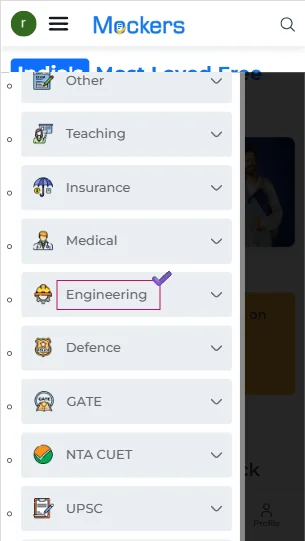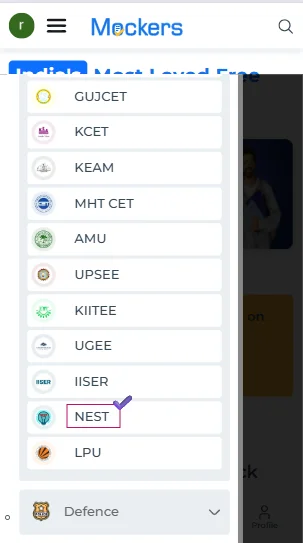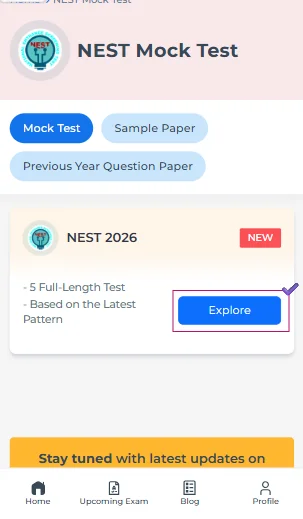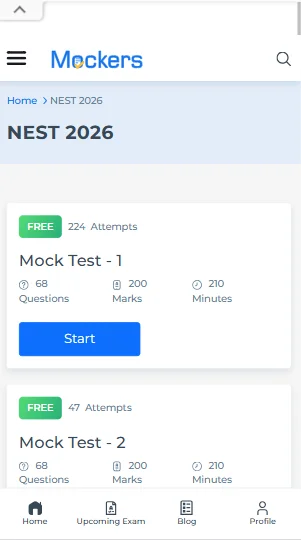NEST Mock Test 2026
In India, an examination known as the National Entrance Screening Test is held every year. It is a compulsory test for admission into the National Institute of Science Education and Research (NISER), Bhubaneswar, and the University of Mumbai - Department of Atomic Energy Centre for Excellence in Basic Sciences (UM-DAE CEBS), Mumbai. The nature of this exam is very competitive, which makes it challenging to clear. That’s where the digital platform of Mockers steps in to make your preparation journey smarter, easier, and completely free with the help of the NEST mock test. It is designed by our subject-matter experts to replicate the actual exam environment as well as help you build confidence before the real test.
Whether you are taking the exam for the first time or want to improve your past performance, by taking the NEST mock test 2026, you will be able to recognize your strengths and weaknesses. You also get instant feedback, detailed solutions, and performance analytics - all at zero cost on our website. So, don’t waste any more time and start attempting these tests today.
Overview Of The National Entrance Screening Test
Below are the details related to the NEST that you should be aware of before taking it.
| APSPECT | DESCRIPTION |
| Name of the Test | NEST: National Entrance Screening Test |
| Test Conducting Authority | NISER: National Institute of Science Education and Research, Bhubaneswar UM-DAE CEBS: University of Mumbai - Department of Atomic Energy Centre for Excellence in Basic Sciences, Mumbai |
| Purpose of the Test | Admission to the five-year Integrated MSc programme in Biology, Chemistry, Mathematics, and Physics at NISER and UM-DAE CEBS. |
| Mode of the Test | Online: Computer-based test |
| Sections in the Test | Four sections
|
| Types of Questions in the Test | Multiple-choice questions |
| Total Marks in the Test | 240 marks (60 marks for each section) |
| Total Questions in the Test | 80 questions (20 questions in each section) |
| Language of the Question Paper | Hindi and English |
| Marking Scheme in the Test |
|
| NEST Application Fee |
|
| Merit List Criteria | Prepared using the best three scores out of the four sections, and the section with the lowest score will not be considered. That is, scores out of 180 marks will be considered for preparing the merit list. |
What Makes Mockers’ NEST Mock Test 2026 Stand Out?
Some points that highlight the unique features and advantages of our NEST online mock test are mentioned in detail below.
- Every mock test for NEST on our platform is curated carefully in order to reflect the latest question pattern, sectional format, marking scheme, and difficulty level as per the guidelines for the exam. In this way, we make sure that you are not caught off guard on the exam day.
- In our NEST free mock test, you will find a real-time countdown timer. This replicates the actual interface of the examination. With this, you can build your stamina, manage time wisely, adapt to real exam pressure, and so on, easily from the comfort of your home.
- Once you have completed the NEST mock test online free, you will receive a report of your performance. It will include section-wise and subject-wise scores, speed and accuracy metrics, analysis of attempted vs. skipped questions, comparison with top performers, etc. With the help of these analytics, you can adjust your study strategy in an effective manner.
- We provide the NEST mock test with answers and step-by-step explanations. They are designed by our experts with a focus on concepts, shortcuts, and error-prevention techniques. These solutions are quite ideal for deep learning as well as conceptual clarity.
- On our website, you get the full-length NEST mock test and subject-specific NEST sample papers. By attempting, you will be able to find and strengthen your weaker areas. The tests will also help you to enhance your overall readiness for the actual test.
Eligibility Criteria For Admission To The Programs Offered Through NEST
In this section, we have described the criteria that you need to fulfill to become eligible for admission into the offered programs.
Educational qualification
- For the Integrated MSc program at NISER and UM–DAE CEBS, you must be enrolled in classes XI and XII of the regular science stream. It is mandatory for you to take the National Entrance Screening Test.
- You should have passed class XII examination from any accredited Indian board in the past or the same year.
- Additionally, in order to be admitted to NISER and UM-DAE CEBS, you must receive at least 60% marks in the aggregate in your class XII exam or an equivalent grade. If you meet all of the aforementioned requirements, then only you will be admitted if you are selected from the NEST Merit List.
- Candidates from the scheduled castes (SC), scheduled tribes (ST), and Divyangjan categories are exempt from the minimum score criterion, which is reduced to 55% in the class XII test or an equivalent grade. A certificate from the relevant Board indicating an equivalent percentage of marks must be supplied in cases where only letter grades are available. The admissions committee of the relevant institution will make the final decision in the absence of such a certificate.
Age limit
- There is no upper age limit to take the NEST 2025 exam and get admitted to UM-DAE CEBS or NISER.
Reservation of Seats
There are 200 seats available at NISER and 57 at UM-DAE CEBS for the Integrated MSc program. The Government of India's seat-reservation regulations are followed by NISER and UM-DAE CEBS. The following are the categories and the scope of the reservation:
- Other Backward Classes in the Non-Creamy Layer (OBC-NCL): OBC-NCL seats make up 27% of the total. The central list of OBCs has included information about the class. You must present the appropriate, valid certificate on the day of admission if you are accepted under the OBC-NCL category. Reservations are not available to candidates from the creamy layer of OBC. These applicants are regarded as being under the General category. According to some state governments, members of the Socially and Educationally Backward Classes (SEBC) are not eligible for any reservations unless they meet the OBC-NCL requirements. Economically Weaker Sections (EWS) of society may only be admitted to UM-DAE CEBS under the General-EWS category.
- Scheduled Caste (SC) / Scheduled Tribe (ST): 15% of seats are set aside for candidates in the Scheduled Caste (SC) and 7.5% are set aside for candidates in the Scheduled Tribe (ST) category. Only castes and tribes listed in the applicable state lists released by the Indian government would be eligible for reservations. According to the Government of India regulations, a certain number of seats are set aside for SC, ST, OBC (Non-Creamy-Layer), and Divyangjan candidates. At the time of entrance, the necessary paperwork must be provided in order to claim seats under the reserved category. Either Hindi or English should be used to write all category certificates. If a certificate is written in a different language, a properly notarised translated copy must also be supplied.
- Divyangjan: Every category, including General, OBC-NCL, SC, and ST, has 5% of seats set aside for people with disabilities (Divyangjan). Regardless of the kind of disability, only individuals with at least 40% impairment would be eligible for benefits. This subcategory also includes individuals who have recovered from leprosy and are otherwise medically suitable to enrol in the course. It is recommended that candidates confirm that the certificate complies with the most recent directives from the Indian government. Because of the horizontal nature of the Divyangjan candidate reservation, vacant seats will be given to candidates in the corresponding categories; for example, empty SC (Divyangjan) seats will be given to candidates in the SC category, and so on. The offer of admission will be revoked if the candidates fail to present all original certificates at the time of admission, if they are chosen.
How To Take The NEST Online Mock Test On Our Platform?
For attempting the NEST mock test 2026, have a look at the steps given below and follow them accordingly.
- Mockers can be reached by opening any browser on the device and searching for it.
- Once the homepage is available, you have to select the ‘Navigation’ bar and click on the section of ‘Exam Categories.’

- This will further open a list where you need to click on the ‘Engineering’ option.
- Now, from the various exams, you can select the ‘NEST’ icon.
- In a while, you will see a new web page that has the NEST online mock test.
- By clicking on the ‘Explore’ button, you can check out different sets of the mock test for NEST.
- Lastly, you can begin with your attempts at the NEST free mock test and enhance your problem-solving skills.
Syllabus Of The National Entrance Screening Test
Here, you will find the entire syllabus that is a part of the National Entrance Screening Test and from which we design the questions of our NEST mock test with answers. This syllabus is mainly from the class 11 and class 12 NCERT/CBSE.
| SECTION | TOPICS/SUBTOPICS | |
| Biology | Class 11 | Diversity in the Living World
|
| Class 12 | Reproduction
|
|
| Chemsitry | Class 11 | Some Basic Concepts of Chemistry
|
| Class 12 | Solid State
|
|
| Mathematics | Class 11 | Sets and Functions
|
| Class 12 | Relations and Functions
|
|
| Physics | Class 11 | Physical World and Measurement
|
| Class 12 | Electrostatics
|
|
How To Use The Mock Test For NEST In Your Preparation Strategy?
When you use the NEST mock test effectively, it can become a powerful tool to optimize your study plan, track your progress, build exam-day confidence, and so on. Here’s how to include this resource smartly in your preparation strategy.
- We have analyzed that a number of students leave the NEST mock test 2026 for the final stage of preparation, which is a huge mistake. You should start taking them after completing around 40 to 50% of the syllabus. This way, you will get a realistic idea of where you stand properly before the exam.
- You must not wait to finish the entire syllabus to take the NEST online mock test. Instead, you can attempt section-wise sample papers and reinforce the concepts right after studying them. You will be able to improve your retention as well as make sure to do practical application of theoretical knowledge.
- It is recommended to take the mock test for NEST in a quiet room, just like the exam. By doing so, you can build your mental stamina, improve your time management, as well as train your brain to stay focused under pressure.
- After the completion of the NEST free mock test, you have to review every incorrect and skipped question, classify your errors (concept gaps, silly mistakes, or time pressure), and maintain an “Error Log” to track your repeated mistakes. In this way, you can turn every test into a powerful learning session.
- Once you have analyzed your NEST mock test online free result, you should seek help on the difficult questions. It can be from your teachers, peers, etc. If you understand even one tricky question properly, then it can give you more benefits than solving ten easy ones.
Important Things To Remember For The National Entrance Screening Test
Below are some points related to the exam, as well as the NEST online application that you must remember carefully.
NEST Examination
- It is recommended that you arrive at the testing location at least sixty minutes prior to the exam's start time.
- You will not be permitted to enter the examination room after 30 minutes have passed since the exam began.
- Unless there is a medical emergency, you will not be permitted to leave the exam room no sooner than two hours after the exam begins.
- To enter the exam room, you must bring both your admit card and a current photo ID card. You might not be permitted to access the testing location without these documents.
- Calculators and log tables are not permitted in the exam room. You are required to bring your own black or blue pen. In the exam room, blank pages will be available for rough work. There will be a basic calculator available on the screen.
- Mobile phones, smart watches, digital devices, storage devices, and other electronic equipment of any type are prohibited in the examination room.
NEST Online Application
- You must enter the proper email address. This email address is the only one used by the NEST office to contact you.
- You should be able to reach the phone number you gave on the application. This phone number is used by the NEST office to contact or deliver SMS messages as needed.
- Upload a current passport-sized photo that has been correctly scanned and cropped. It is necessary to supply a correctly cropped and scanned signature.
- The signature and photo files must only be in JPG or JPEG format and cannot exceed 80 KB each.
- Applications that are not complete in any way will not be accepted.
- The Odisha High Court will have jurisdiction over any disputes pertaining to the NEST exam.
Proposed Students Intake
The number of seats available at NISER and CEBS for admission would be as follows.
| CATEGORY | NISER | UM-DAE CEBS |
| General | 101 | 23 |
| General - EWS | 0 | 06 |
| OBC - NCL | 54 | 15 |
| SC | 30 | 09 |
| ST | 15 | 04 |
| Divyangjan | 5% seats in each category | 5% seats in each category |
| Total Intake | 200 | 57 |
- According to current government regulations, two supernumerary seats are set aside at both NISER and CEBS for qualified applicants from Jammu & Kashmir, Ladakh.
- If a student achieves a suitable general ranking, they will be assigned to a general seat.
- For instance, if an OBC candidate manages to be the exam's best scorer (General rank 1), they will also receive OBC rank 1. To ensure that all OBC seats are still available following their admission, in such a scenario, they would be admitted against the General rank.
Best Time To Start Taking NEST Free Mock Test
Once you know when to start attempts at the NEST mock test with answers, you will be able to sharpen all the important skills in an effective manner before the exam. Below are some points on how to time it right and use the tests throughout your preparation journey.
- After completing 40 to 50% of the syllabus (early-mid stage)
This is the ideal timing to start with the NEST mock test. You can begin with the sectional or subject-wise mock tests during this time. You should also not worry about your scores and focus on getting familiar with the question styles and time limits. In this way, you will be able to connect the gap between your learning and applying what you have studied.
- Every 2 weeks during active preparation
Once you have started, you should make the NEST mock test 2026 a routine part of your preparation cycle. Every 10 to 14 days, you need to take a full-length mock test, follow it up with deep analysis and targeted revision, etc. Make sure that you note question types that confuse you or consistently slow you down.
- Right After Finishing the Entire Syllabus (Around 8–10 Weeks Before Exam)
This is the phase where you have to increase the frequency of NEST online mock test attempts. Now, you should take 2 full-length mocks every week, mix in revision of past weak topics, as well as focus on consistency, time management, and mental endurance.
- Final 4 Weeks Before the Exam - Peak Mock Test Phase
This is the stage of polishing your performance. During this time, you have to attempt 3 to 4 mock test for NEST per week, along with in-depth analysis on alternate days. We also advise you to practice at the same time of day as the actual NEST exam. Your main focus should be on fine-tuning your time allocation, guesswork strategy, stamina, and so on.
Centers For The National Entrance Screening Test
There are more than 100 cities and towns in India that have been selected to conduct the NEST. Below is a list of all these exam centers for your reference, so you can choose the nearest place and take this test.
| NEST CENTERS | |||
| Port Blair (Andaman and Nicobar Islands) | Guntur (Andhra Pradesh- AP) | Kurnool (AP) | Rajahmundry (AP) |
| Tirupathi (AP) | Vijayawada (AP) | Visakhapatnam (AP) | Vizianagaram (AP) |
| Naharlagun (Arunachal Pradesh) | Dibrugarh (Assam- AS) | Guwahati (AS) | Tezpur (AS) |
| Bhagalpur (Bihar- BR) | Patna (BR) | Bhilai Nagar (Chhattisgarh- CG) | Raipur (CG) |
| New Delhi (DL) | Panaji (Goa) | Ahmedabad (Gujarat- GJ) | Bhuj (GJ) |
| Rajkot (GJ) | Surat (GJ) | Hisar (Haryana- HR) | Kurukshetra (HR) |
| Hamirpur (Himachal Pradesh- HP) | Shimla (HP) | Jammu (Jammu and Kashmir- JK) | Srinagar (JK) |
| Bokaro Steel City (Jharkhand- JH) | Dhanbad (JH) | Jamshedpur (JH) | Ranchi (JH) |
| Bengaluru (Karnataka- KA) | Hubballi (KA) | Mangaluru (KA) | Mysuru (KA) |
| Alappuzha (Kerala- KL) | Ernakulam (KL) | Idukki (KL) | Kannur (KL) |
| Kasaragod (KL) | Kollam (KL) | Kollam (KL) | Kottayam (KL) |
| Kozhikode (KL) | Malappuram (KL) | Palakkad (KL) | Pathanamthitta (KL) |
| Thiruvananthapuram (KL) | Thrissur (KL) | Wayanad (KL) | Leh (Ladakh) |
| Bhopal (Madhya Pradesh- MP) | Gwalior (MP) | Indore (MP) | Jabalpur (MP) |
| Aurangabad (Maharashtra- MH) | Jalgaon (MH) | Kolhapur (MH) | Mumbai (MH) |
| Nagpur (MH) | Nanded (MH) | Pune (MH) | Ratnagiri (MH) |
| Solapur (MH) | Imphal (Manipur) | Shillong (Meghalaya) | Aizawl (Mizoram) |
| Dimapur (Nagaland- NL) | Kohima (NL) | Angul (Odisha- OD) | Balangir (OD) |
| Balasore (OD) | Bargarh (OD) | Baripada (OD) | Berhampur (OD) |
| Bhadrak (OD) | Bhawanipatna (OD) | Bhubaneswar (OD) | Boudh (OD) |
| Cuttack (OD) | Deogarh (OD) | Dhenkanal (OD) | Jagatsinghpur (OD) |
| Jajpur (OD) | Jeypore (OD) | Jharsuguda (OD) | Kendrapara (OD) |
| Keonjhar (OD) | Malkangiri (OD) | Nayagarh (OD) | Nuapada (OD) |
| Paralakhemundi (OD) | Phulbani (OD) | Puri (OD) | Rayagada (OD) |
| Rourkela (OD) | Sambalpur (OD) | Sonepur (OD) | Sundargarh (OD) |
| Umerkote (OD) | Puducherry (Puducherry) | Bhatinda (Punjab- PB) | Jalandhar (PB) |
| Chandigarh (PB) | Mohali (PB) | Bikaner (Rajasthan- RJ) | Jaipur (RJ) |
| Jodhpur (RJ) | Kota (RJ) | Udaipur (RJ) | Gangtok (Sikkim) |
| Chennai (Tamil Nadu- TN) | Coimbatore (TN) | Madurai (TN) | Salem (TN) |
| Tiruchirappalli (TN) | Tirunelveli (TN) | Hyderabad (Telangana- TS) | Karimnagar (TS) |
| Warangal (TS) | Agartala (Tripura) | Agra (Uttar Pradesh- UP) | Aligarh (UP) |
| Gorakhpur (UP) | Kanpur (UP) | Lucknow (UP) | Noida (UP) |
| Prayagraj (UP) | Varanasi (UP) | Dehradun (Uttarakhand- UK) | Haldwani (UK) |
| Roorkee (UK) | Asansol (West Bengal- WB) | Berhampur (WB) | Burdwan (WB) |
| Durgapur (WB) | Hooghly (WB) | Kalyani (WB) | Kolkata (WB) |
| Siliguri (WB) | |||
Conclusion
The Mockers’ NEST free mock test plays a game-changing role in your exam preparation. With their help, you can get comfortable with the exam pattern, refine your time management, pinpoint your weaknesses, steadily improve your performance, and so on. This high-quality free practice material also gives you the chance to gain confidence at zero cost. Also, make sure that you not just study, but, simulate, analyze, and improve. Make these mock tests a core part of your strategy and walk into the exam hall ready.
 Bank
Bank







 SSC
SSC









 Railway
Railway







 State
State




 Other
Other


 Teaching
Teaching




 Insurance
Insurance


 Medical
Medical



 Engineering
Engineering




















 Defence
Defence





 GATE
GATE





 NTA CUET
NTA CUET

 UPSC
UPSC

 MBA Entrance
MBA Entrance

















 LAW
LAW

 JEE Main 2026 : Session 1
JEE Main 2026 : Session 1
 CAT 2025
CAT 2025
 SSC CHSL 2025
SSC CHSL 2025
 SSC MTS 2025
SSC MTS 2025
 IBPS RRB 2025
IBPS RRB 2025
 Railway Group D 2025
Railway Group D 2025
 RRB ALP CBT-I 2025
RRB ALP CBT-I 2025
 CTET 2025 Paper I
CTET 2025 Paper I
 UP Police SI (दरोगा) 2025
UP Police SI (दरोगा) 2025
 SSC CPO Tier I 2025
SSC CPO Tier I 2025
 DSSSB PRT 2025
DSSSB PRT 2025
 SSC JE 2025
SSC JE 2025
 Delhi Police Constable 2025
Delhi Police Constable 2025


















 Get latest Exam Updates
Get latest Exam Updates 



